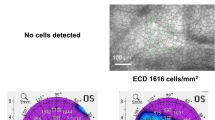Summary
Histological studies of interlamellar keratoplasty in different inbred strains of rats (CAP, LEW) without additional sensitization — i.e. first-set reactions — are described.
The corneas of 65 eyes, after allogeneic or syngeneic grafting, were examined from the 3rd to the 90th day — every 2nd day at the beginning of the reaction and later every 5th day. After syngeneic grafting (LEW → LEW) a non-specific healing-reaction (only slight vascularization of the graft bed, edema, granulocytic infiltration) reached its climax on the 6th day and subsided by the 10th day. After allogeneic grafting (CAP → LEW; RtH-1-incompatible) the non-specific-healing reaction progressed into a second phase, namely the specific reaction: increasing infiltration of the host cornea and the graft with small lymphocytes, blast cells and macrophages, directly followed by severe vascularization, reaching its climax about the 14th day. A third, phagocytic phase succeeded the infiltration leading to elimination of the donor cells, but leaving the donor stroma undamaged. All these alterations had almost completely disappeared after 35 days.
Thus, the corneal allograft reaction is discussed as a typical immunological reaction leading to the destruction of transplantation-antigen-bearing cells and permitting observation of the different reaction phases more clearly than in most other tissues.
Zusammenfassung
Die nach interlamellärer Keratoplastik bei Inzuchtratten (CAP, LEW) biomikroskopisch beobachteten allogenen Abstoßungsreaktionen, die ohne zusätzliche Sensibilisierung — durch limbusnahe Hornhautverpflanzung — erzeugt wurden, also first-set-Reaktionen sind, sollen in dieser Arbeit histologisch untersucht werden.
Über einen Zeitraum von 3 bis 90 Tagen werden zu Beginn der Reaktion jeden 2. Tag und später jeden 5. Tag je 3 Augen enukleiert (insgesamt 65 Augen) und histologisch untersucht.
Nach syngener Verpflanzung (als Kontrolle; LEW → LEW) wurde eine unspezifische, durch das operative Trauma bedingte, Entzündungsreaktion beobachtet, die gekennzeichnet ist durch granulozytäre Infiltration, Ödem und geringe Vaskularisation des Transplantatbettes. Am 6. Tag hat sie ihr Maximum erreicht und ist am 10. Tag beendet.
Nach allogener Verpflanzung (CAP → LEW; RtH-1-inkompatibel) mündet die unspezifische Entzündungsreaktion in eine spezifische Reaktion, die charakterisiert ist durch zunehmende Infiltration mit kleinen Lymphozyten, Lymphoblasten und Makrophagen sowie durch Ödembildung, unmittelbar gefolgt von einer starken Vaskularisation. Die spezifische Reaktion erreicht ihren Höhepunkt am 14. Tag. Sie wird abgelöst von einer phagozytären Phase mit Beseitigung der nekrotischen Spenderzellen (Epithel, Endothel, Keratozyten). Nach 35 Tagen bleibt lediglich ein unversehrtes klares Spenderstroma zurück.
Deshalb wird die Abstoßung des Hornhauttransplantates als eine spezifisch immunologische Reaktion angesehen, bei der die Zellen zerstört werden, die Transplantationsantigene tragen. Hingewiesen wird auf den phasenhaften Verlauf der Reaktion, der bei Abstoßungsvorgängen anderer Gewebe nicht so klar beobachtet werden kann.
Similar content being viewed by others
References
Fromer, C.H., Klintworth, G.K.: An evaluation of the role of leukocytes in the pathogenesis of experimentally induced corneal vascularization. Amer. J. Path. 81, 531–540 (1975)
Greaves, M.F., Owen, J.J.T., Raff, M.C.: T- and B-lymphocytes: origins, properties and roles in immune responses. Excerpta Medica. New York: American Elsevier Publishing Co., Inc.: 1973
Gronemeyer, U., Müller-Ruchholtz, W.: Kortikoid-induzierte Hemmung der Sensibilisierung durch corneale Transplantationsantigene. In: Kortikosteroide in der Augenheilkunde W. Böke, ed.), pp. 68–74. München: J.F. Bergmann 1973
Gronemeyer, U., Müller-Ruchholtz, W.: Allogene Hornhaut-Transplantation bei Inzuchtratten. IV. Bedeutung des Histoinkompatibilitätsgrades zwischen Spender und Empfänger. Albrecht v. Graefes Arch. klin. exp. Ophthal. 190, 309–317 (1974a)
Gronemeyer, U., Müller-Ruchholtz, W.: Allogene Hornhauttransplantation bei Inzuchtratten. VI. Bedeutungder Transplantat-Lokalisation. (Cornea als “privileged site”) Albrecht v. Graefes Arch. klin. exp. Ophthal. 191, 139–150 (1974b)
Gowans, J.L.: Cellular mediators of allograft immunity. Transpl. Proc. IX, 685–690 (1977)
Inomata, H., Smelser, G.K., Polack, F.M.: Corneal vascularization in experimental uveitis and graft rejection. An electron microscopic study. Invest. Ophthal. 10, 840–850 (1971)
Khodadoust, A.A., Silverstein, A.M.: Transplantation and rejection of individual cell layers of the cornea. Invest. Ophthal. 8, 180–195 (1969)
Khodadoust, A.A., Silverstein, A.M.: Studies on the nature of the privilege enjoyed by corneal allografts. Invest. Ophthal. 11, 137–148 (1972)
Nabarra, B., Descamps, B., Hamburger, J.: Cell infiltration in human renal allografts: An ultrastructural study. Transpl. Proc. VII., Suppl. 1, 645–647 (1975)
Polack, F.M.: Histopathological and histochemical alterations in the early stages of corneal graft rejection. J. Exp. Med. 116, 709–717 (1962)
Polack, F.M.: Corneal graft rejection: clinico-pathological correlation. In: Corneal graft failure. Ciba Foundation Symposium 15. (R. Porter and J. Knight, eds.), pp. 127–140. Amsterdam: Excerpta Medica 1973
Richardson, K.C., Jarett, L., Finke, E.H.: Embedding in epoxy resins for ultrathin sectioning in electron microscopy. Stain Technol. 35, 313–323 (1960)
Seifert, K.: Zur Orientierung inhomogener Gewebeeinbettungen für die Ultramikrotomie. Mikroskopie 17, 231–234 (1962)
Waksman, B.H.: A comparative histopathological study of delayed hypersensitive reactions. In: Cellular aspects of immunity. Ciba Foundation Symposium, (G.E.W. Wolstenholme and M. O'Connor, eds.), pp. 280–327. Boston: Little Brown 1960
Waksman, B.H.: Atlas of experimental immunbiology. New Haven, Conn: Yale University Press 1970
Wiener, J., Spiro, D., Russel, P.S.: An electron microscopic study of the homograft reaction. Amer. J. Path. 44, 319–331 (1964)
Author information
Authors and Affiliations
Additional information
The authors wish to thank Mrs. Dagmar Graf for her excellent technical assistance
Rights and permissions
About this article
Cite this article
Gronemeyer, U., Pülhorn, G. & Müller-Ruchholtz, W. Allogeneic corneal grafting in inbred strains of rats. Albrecht von Graefes Arch. Klin. Ophthalmol. 208, 247–262 (1978). https://doi.org/10.1007/BF00419380
Received:
Issue Date:
DOI: https://doi.org/10.1007/BF00419380




